GEO–GEO Stereo-Tracking of Atmospheric Motion Vectors (AMVs) from the Geostationary Ring
Abstract
1. Introduction
2. Materials and Methods
2.1. GOES-GEO Stereo Winds Coverage
2.2. GOES-GEO Stereo Winds Approach
2.3. Pixel Time Tags
2.4. Spacecraft Position Vectors
2.5. Divergence and Curl
3. Results
3.1. Validation
3.1.1. Ground Point Retrievals
3.1.2. Rawinsondes
- u-component of satellite wind,
- v-component of satellite wind,
- u-component of the collocated reference wind,
- v-component of the collocated reference wind and,
- size of collocated sample.
3.2. Statistics of Stereo Height and Winds
3.2.1. Cloud Features
3.2.2. Water Vapor Features
3.3. Applications
3.3.1. Deep Convection from Tropical Cyclones
3.3.2. Planetary Boundary Layer (PBL)
3.3.3. Fire Plumes
4. Discussion
4.1. Error Analysis
4.1.1. INR Errors
- km, has with only nonzero state = 3.33 m/s,
- km, has with only nonzero state = 3.33 m/s,
- km, has only = 500 m and h = 685 m being nonzero.
4.1.2. Ephemeris Errors
4.1.3. Time Assignment Errors
4.1.4. Stereo Sensitivity versus Coverage
4.2. Orographic Cloud Effects
4.3. Rawinsonde Comparisons and NWP Implications
5. Conclusions
Supplementary Materials
Author Contributions
Funding
Acknowledgments
Conflicts of Interest
Appendix A
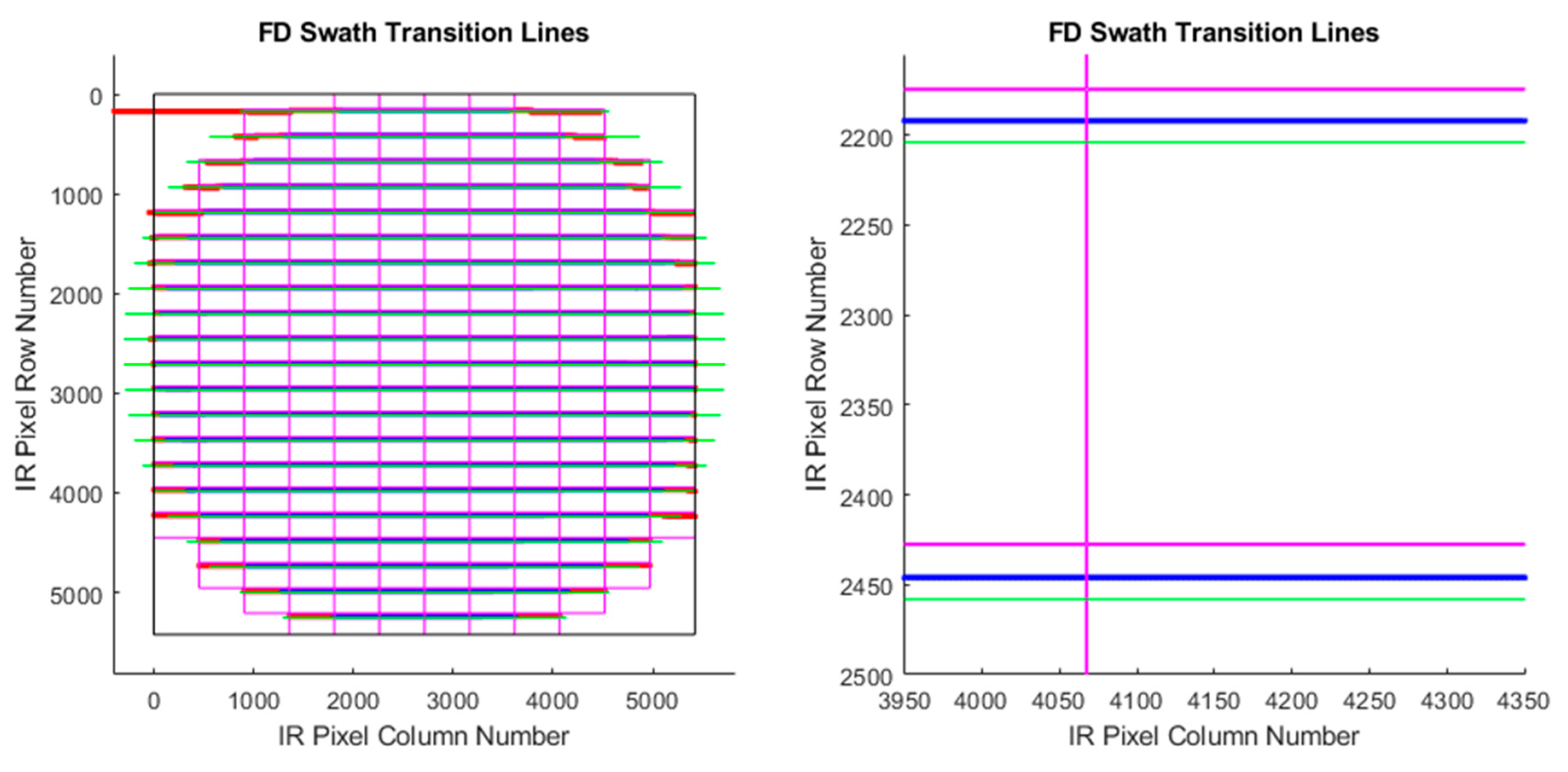
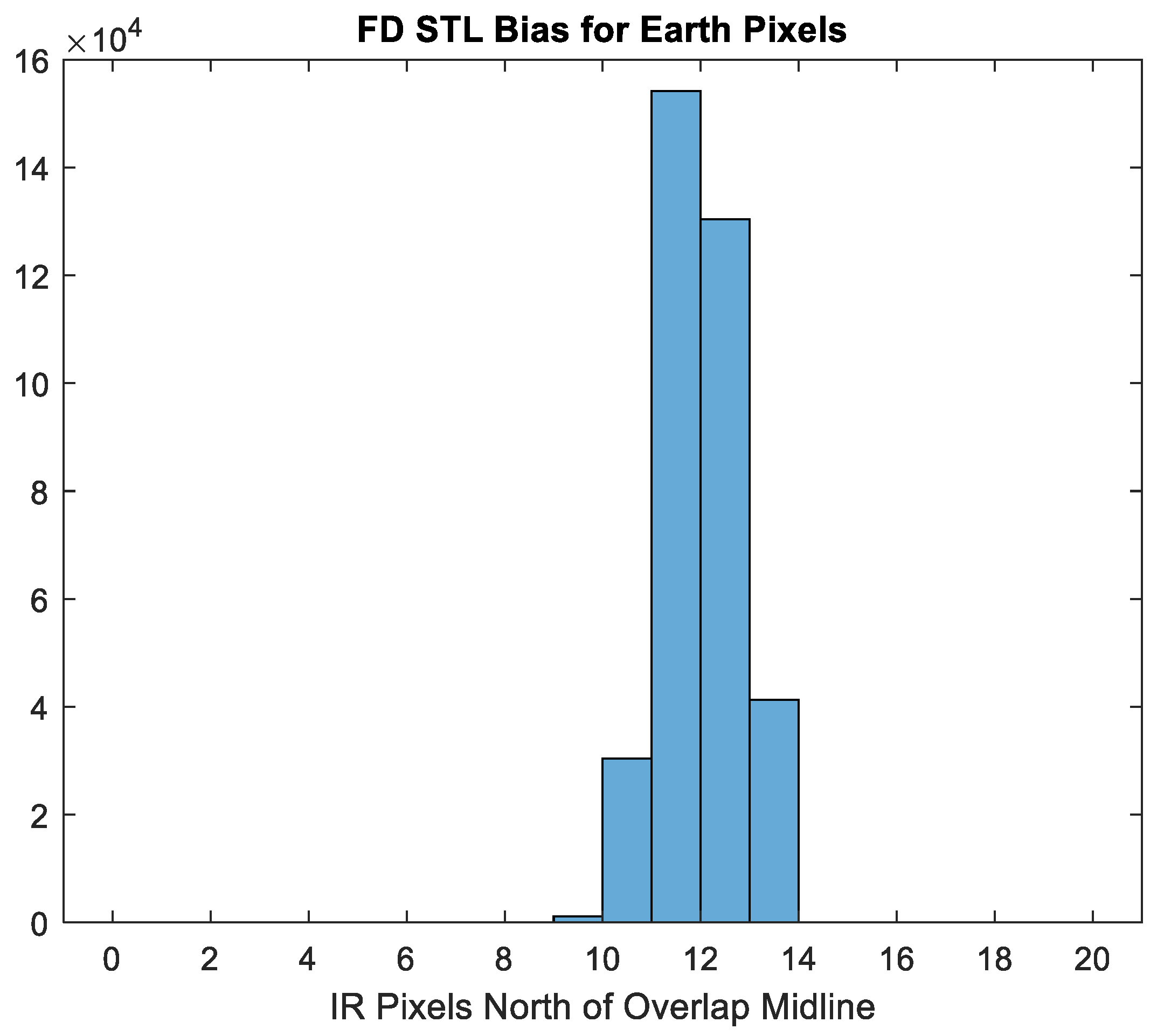
| Band | 1 | 2 | 3 | 4 | 5 | 6 | 7 | 8 |
| seconds | 0.179 | −0.055 | 0.402 | 0.642 | −0.359 | −0.642 | 0.535 | 0.267 |
| Band | 9 | 10 | 11 | 12 | 13 | 14 | 15 | 16 |
| seconds | 0.000 | −0.267 | −0.535 | −0.542 | 0.551 | 0.319 | −0.256 | 0.579 |
References
- Menzel, W.P.; Smith, W.L.; Stewart, T.R. Improved Cloud Motion Wind Vector and Altitude Assignment Using VAS. J. Clim. Appl. Meteorol. 1983, 22, 377–384. [Google Scholar] [CrossRef]
- Szejwach, G. Determination of Semi-Transparent Cirrus Cloud Temperature from Infrared Radiances: Application to METEOSAT. J. Appl. Meteorol. 1982, 21, 384–393. [Google Scholar] [CrossRef]
- Schmetz, J.; Holmlund, K.; Hoffman, J.; Strauss, B.; Mason, B.; Gaertner, V.; Koch, A.; Van De Berg, L. Operational Cloud-Motion Winds from Meteosat Infrared Images. J. Appl. Meteorol. 1993, 32, 1206–1225. [Google Scholar] [CrossRef]
- Nieman, S.J.; Schmetz, J.; Menzel, W.P. A Comparison of Several Techniques to Assign Heights to Cloud Tracers. J. Appl. Meteorol. 1993, 32, 1559–1568. [Google Scholar] [CrossRef]
- Frey, R.A.; Baum, B.A.; Menzel, W.P.; Ackerman, S.A.; Moeller, C.C.; Spinhirne, J.D. A comparison of cloud top heights computed from airborne lidar and MAS radiance data using CO2 slicing. J. Geophys. Res. Atmos. 1999, 104, 24547–24555. [Google Scholar] [CrossRef]
- Heidinger, A.K.; Pavolonis, M.J. Gazing at Cirrus Clouds for 25 Years through a Split Window. Part I: Methodology. J. Appl. Meteorol. Clim. 2009, 48, 1100–1116. [Google Scholar] [CrossRef]
- Borde, R.; Doutriaux-Boucher, M.; Dew, G.; Carranza, M. A Direct Link between Feature Tracking and Height Assignment of Operational EUMETSAT Atmospheric Motion Vectors. J. Atmos. Ocean. Technol. 2014, 31, 33–46. [Google Scholar] [CrossRef]
- Bresky, W.; Daniels, J.; Bailey, A.A.; Wanzong, S.T. New Methods toward Minimizing the Slow Speed Bias Associated with Atmospheric Motion Vectors. J. Appl. Meteorol. Clim. 2012, 51, 2137–2151. [Google Scholar] [CrossRef]
- Hasler, A.F. Stereographic Observations from Geosynchronous Satellites: An Important New Tool for the Atmospheric Sciences. Bull. Am. Meteorol. Soc. 1981, 62, 194–212. [Google Scholar] [CrossRef]
- Carr, J.L.; Wu, D.L.; Kelly, M.A.; Gong, J. MISR-GOES 3D Winds: Implications for Future LEO-GEO and LEO-LEO Winds. Remote Sens. 2018, 10, 1885. [Google Scholar] [CrossRef]
- Carr, J.L.; Wu, D.L.; Wolfe, R.; Madani, H.; Lin, G.; Tan, B. Joint 3D-Wind Retrievals with Stereoscopic Views from MODIS and GOES. Remote Sens. 2019, 11, 2100. [Google Scholar] [CrossRef]
- Lee, J.; Shin, D.-B.; Chung, C.-Y.; Kim, J. A Cloud Top-Height Retrieval Algorithm Using Simultaneous Observations from the Himawari-8 and FY-2E Satellites. Remote Sens. 2020, 12, 1953. [Google Scholar] [CrossRef]
- Dehnavi, S.; Maghsoudi, Y.; Zakšek, K.; Zoej, M.V.; Seckmeyer, G.; Skripachev, V. Cloud Detection Based on High Resolution Stereo Pairs of the Geostationary Meteosat Images. Remote Sens. 2020, 12, 371. [Google Scholar] [CrossRef]
- Merucci, L.; Zakšek, K.; Carboni, E.; Corradini, S. Stereoscopic Estimation of Volcanic Ash Cloud-Top Height from Two Geostationary Satellites. Remote Sens. 2016, 8, 206. [Google Scholar] [CrossRef]
- Lindsey, D.T.; Griffin, V.; Schrab, K.; Sulliva, P. The GOES-17 Advanced Baseline Imager Anomaly Mission Recovery. In Proceedings of the Joint AMS EUMETSAT Satellite Conference, Boston, MA, USA, 28 September–4 October 2019. [Google Scholar]
- NOAA-NESDIS. GOES-17 Loop Heat Pipe Fact Sheet. 2018. Available online: https://www.nesdis.noaa.gov/sites/default/files/asset/document/NESDIS_factsheet_loopheatpipe.pdf (accessed on 22 September 2020).
- Schmit, T.J.; Gunshor, M.M.; Menzel, W.P.; Gurka, J.J.; Li, J.; Bachmeier, A.S. Introducing the next-generation advanced baseline imager on GOES-R. Bull. Am. Meteorol. Soc. 2005, 86, 1079–1096. [Google Scholar] [CrossRef]
- Schmit, T.J.; Griffith, P.; Gunshor, M.M.; Daniels, J.; Goodman, S.J.; Lebair, W.J. A Closer Look at the ABI on the GOES-R Series. Bull. Am. Meteorol. Soc. 2017, 98, 681–698. [Google Scholar] [CrossRef]
- Bessho, K.; Date, K.; Hayashi, M.; Ikeda, A.; Imai, T.; Inoue, H.; Kumagai, Y.; Miyakawa, T.; Murata, H.; Ohno, T.; et al. An Introduction to Himawari-8/9—Japan’s New-Generation Geostationary Meteorological Satellites. J. Meteorol. Soc. Jpn. 2016, 94, 151–183. [Google Scholar] [CrossRef]
- GOES R SERIES PRODUCT DEFINITION AND USERS’ GUIDE (PUG). 2018. Available online: https://www.goes-r.gov/users/docs/PUG-main-vol1.pdf (accessed on 22 September 2020).
- Coordination Group for Meteorological Satellites (CGMS). LRIT/HRIT Global Specification. 1999. Available online: https://www.cgms-info.org/documents/pdf_cgms_03.pdf (accessed on 22 September 2020).
- Durand, Y.; Hallibert, P.; Wilson, M.; Lekouara, M.; Grabarnik, S.; Aminou, D.; Blythe, P.; Napierala, B.; Canaud, J.-L.; Pigouche, O.; et al. The flexible combined imager onboard MTG: From design to calibration. In Proceedings of the Sensors, Systems, and Next-Generation Satellites XIX, Toulouse, France, 13 October 2015. [Google Scholar] [CrossRef]
- Borde, R.; Carranza, M.; Hautecoeur, O.; Barbieux, K.S. Winds of Change for Future Operational AMV at EUMETSAT. Remote Sens. 2019, 11, 2111. [Google Scholar] [CrossRef]
- Ken, A.; King, T.S.; Wolf, W. Software Requirements for Supporting Research-to-Operations at NOAA and Their Implementation in the New SAPF 2.0. In Proceedings of the Joint AMS EUMETSAT Satellite Conference, Boston, MA, USA, 28 September–4 October 2019. [Google Scholar]
- Carr, J.L. Georegistration of meteorological images. In Image Registration for Remote Sensing; Le Moigne, J., Netanyahu, N.S., Eastman, R.D., Eds.; Cambridge University Press: Cambridge, UK, 2011; pp. 339–354. [Google Scholar]
- Himawari-8/9 Himawari Standard Data User’s Guide. 2015. Available online: https://www.data.jma.go.jp/mscweb/en/himawari89/space_segment/hsd_sample/HS_D_users_guide_en_v12.pdf (accessed on 22 September 2020).
- Schmetz, J.; Borde, R.; Holmlund, K.; König, M. Upper tropospheric divergence in tropical convective systems from Meteosat-8. Geophys. Res. Lett. 2005, 32. [Google Scholar] [CrossRef]
- Velden, C.; Daniels, J.; Stettner, D.; Santek, D.; Key, J.; Dunion, J.; Holmlund, K.; Dengel, G.; Bresky, W.; Menzel, P. Recent Innovations in Deriving Tropospheric Winds from Meteorological Satellites. Bull. Am. Meteorol. Soc. 2005, 86, 205–224. [Google Scholar] [CrossRef]
- Moroney, C.; Horváth, Á.; Davies, R. Use of stereo-matching to coregister multiangle data from MISR. IEEE Trans. Geosci. Remote Sens. 2002, 40, 1541–1546. [Google Scholar] [CrossRef]
- Lonitz, K.; Horváth, Á. Comparison of MISR and Meteosat-9 cloud-motion vectors. J. Geophys. Res. Space Phys. 2011, 116. [Google Scholar] [CrossRef]
- Menzel, W.P. Report from the working group on verification statistics. In Proceedings of the Third International Winds Workshop, Ascona, Switzerland, 10–12 June 1996. [Google Scholar]
- PrepBUFR Processing at NCEP. 2018. Available online: https://www.emc.ncep.noaa.gov/mmb/data_processing/prepbufr.doc/document.htm (accessed on 9 November 2020).
- Reale, T.; Sun, B.; Tilley, F.H.; Pettey, M. The NOAA Products Validation System (NPROVS). J. Atmos. Ocean. Technol. 2012, 29, 629–645. [Google Scholar] [CrossRef]
- Ingleby, B.; Pauley, P.; Kats, A.; Ator, J.; Keyser, D.; Doerenbecher, A.; Fucile, E.; Hasegawa, J.; Toyoda, E.; Kleinert, T.; et al. Progress toward High-Resolution, Real-Time Radiosonde Reports. Bull. Am. Meteorol. Soc. 2016, 97, 2149–2161. [Google Scholar] [CrossRef]
- Nieman, S.J.; Menzel, W.P.; Hayden, C.M.; Gray, D.; Wanzong, S.T.; Velden, C.S.; Daniels, J. Fully Automated Cloud-Drift Winds in NESDIS Operations. Bull. Am. Meteorol. Soc. 1997, 78, 1121–1133. [Google Scholar] [CrossRef]
- Heidinger, A.K. NOAA Enterprise Algorithm Theoretical Basis Document for Cloud Height, Version 3.0. 2015. Available online: https://www.star.nesdis.noaa.gov/jpss/documents/ATBD/ATBD_EPS_Cloud_ACHA_v3.0.pdf (accessed on 22 September 2020).
- Heidinger, A.K.; Pavolonis, M.J.; Holz, R.E.; Baum, B.A.; Berthier, S. Using CALIPSO to explore the sensitivity to cirrus height in the infrared observations from NPOESS/VIIRS and GOES-R/ABI. J. Geophys. Res. Space Phys. 2010, 115. [Google Scholar] [CrossRef]
- Wu, D.L.; Ackerman, S.A.; Davies, R.; Diner, D.J.; Garay, M.J.; Kahn, B.H.; Maddux, B.C.; Moroney, C.M.; Stephens, G.L.; Veefkind, J.P.; et al. Vertical distributions and relationships of cloud occurrence frequency as observed by MISR, AIRS, MODIS, OMI, CALIPSO, and CloudSat. Geophys. Res. Lett. 2009, 36. [Google Scholar] [CrossRef]
- Baker, N.L.; Pauley, P.M.; Langland, R.H.; Mueller, K.; Wu, D. An Assessment of the Impact of the Assimilation of NASA TERRA MISR Atmospheric Motion Vectors on the NRL Global Atmospheric Prediction System. Available online: https://ams.confex.com/ams/94Annual/webprogram/Paper231106.html (accessed on 22 September 2020).
- Mueller, K.J.; Liu, J.; Mccarty, W.; Gelaro, R. An Adjoint-Based Forecast Impact from Assimilating MISR Winds into the GEOS-5 Data Assimilation and Forecasting System. Mon. Weather. Rev. 2017, 145, 4937–4947. [Google Scholar] [CrossRef]
- Velden, C.S.; Hayden, C.M.; Nieman, S.J.; Menzel, W.P.; Wanzong, S.; Goerss, J.S. Upper-Tropospheric Winds Derived from Geostationary Satellite Water Vapor Observations. Bull. Am. Meteorol. Soc. 1997, 78, 173–195. [Google Scholar] [CrossRef][Green Version]
- Posselt, D.J.; Wu, L.; Mueller, K.; Huang, L.; Irion, F.W.; Brown, S.; Su, H.; Santek, D.; Velden, C.S. Quantitative Assessment of State-Dependent Atmospheric Motion Vector Uncertainties. J. Appl. Meteorol. Clim. 2019, 58, 2479–2495. [Google Scholar] [CrossRef]
- Nesbitt, S.; Zipser, E.J. The Diurnal Cycle of Rainfall and Convective Intensity according to Three Years of TRMM Measurements. J. Clim. 2003, 16, 1456–1475. [Google Scholar] [CrossRef]
- Bowman, K.P.; Collier, J.C.; North, G.R.; Wu, Q.; Ha, E.; Hardin, J.W. Diurnal cycle of tropical precipitation in Tropical Rainfall Measuring Mission (TRMM) satellite and ocean buoy rain gauge data. J. Geophys. Res. Space Phys. 2005, 110. [Google Scholar] [CrossRef]
- Dunion, J.P.; Thorncroft, C.D.; Velden, C.S. The Tropical Cyclone Diurnal Cycle of Mature Hurricanes. Mon. Weather. Rev. 2014, 142, 3900–3919. [Google Scholar] [CrossRef]
- Jiang, H.; Liu, C.; Zipser, E.J. A TRMM-Based Tropical Cyclone Cloud and Precipitation Feature Database. J. Appl. Meteorol. Clim. 2011, 50, 1255–1274. [Google Scholar] [CrossRef]
- Wylie, D.P.; Santek, D.; Starr, D.O. Cloud-Top Heights fromGOES-8andGOES-9Stereoscopic Imagery. J. Appl. Meteorol. 1998, 37, 405–413. [Google Scholar] [CrossRef]
- Wood, R.; Bretherton, C.S. Boundary Layer Depth, Entrainment, and Decoupling in the Cloud-Capped Subtropical and Tropical Marine Boundary Layer. J. Clim. 2004, 17, 3576–3588. [Google Scholar] [CrossRef]
- Wu, D.; Hu, Y.; McCormick, M.P.; Xu, K.-M.; Liu, Z.; Smith, B.; Omar, A.H.; Chang, F.-L. Deriving Marine-Boundary-Layer Lapse Rate from Collocated CALIPSO, MODIS, and AMSR-E Data to Study Global Low-Cloud Height Statistics. IEEE Geosci. Remote Sens. Lett. 2008, 5, 649–652. [Google Scholar] [CrossRef]
- Klein, S.A.; Hartmann, D.L. The Seasonal Cycle of Low Stratiform Clouds. J. Clim. 1993, 6, 1587–1606. [Google Scholar] [CrossRef]
- Coakley, J.A. Reflectivities of uniform and broken layered clouds. Tellus B Chem. Phys. Meteorol. 1991, 43, 420–433. [Google Scholar] [CrossRef][Green Version]
- Bretherton, C.S.; Wyant, M.C. Moisture Transport, Lower-Tropospheric Stability, and Decoupling of Cloud-Topped Boundary Layers. J. Atmos. Sci. 1997, 54, 148–167. [Google Scholar] [CrossRef]
- Bony, S.; Stevens, B. Measuring Area-Averaged Vertical Motions with Dropsondes. J. Atmos. Sci. 2019, 76, 767–783. [Google Scholar] [CrossRef]
- Savic-Jovcic, V.; Stevens, B. The Structure and Mesoscale Organization of Precipitating Stratocumulus. J. Atmos. Sci. 2008, 65, 1587–1605. [Google Scholar] [CrossRef]
- Garay, M.J.; Davies, R.; Averill, C.; Westphal, J.A. ACTINOFORM CLOUDS: Overlooked Examples of Cloud Self-Organization at the Mesoscale. Bull. Am. Meteorol. Soc. 2004, 85, 1585–1594. [Google Scholar] [CrossRef]
- Feingold, G.; Koren, I.; Wang, H.; Xue, H.; Brewer, W.A. Precipitation-generated oscillations in open cellular cloud fields. Nature 2010, 466, 849–852. [Google Scholar] [CrossRef] [PubMed]
- Cal Fire, Daily Wildfire Update; Stats and Events. 2020; Available online: https://www.fire.ca.gov/daily-wildfire-report/ and https://www.fire.ca.gov/stats-events/; (accessed on 23 September 2020).
- Srock, A.F.; Charney, J.J.; Potter, B.E.; Goodrick, S.L. The Hot-Dry-Windy Index: A New Fire Weather Index. Atmosphere 2018, 9, 279. [Google Scholar] [CrossRef]
- Fromm, M.; Lindsey, D.T.; Servranckx, R.; Yue, G.; Trickl, T.; Sica, R.; Doucet, P.; Godin-Beekmann, S. The Untold Story of Pyrocumulonimbus. Bull. Am. Meteorol. Soc. 2010, 91, 1193–1210. [Google Scholar] [CrossRef]
- Clements, C.B.; Lareau, N.P.; Seto, D.; Contezac, J.; Davis, B.; Teske, C.; Zajkowski, T.J.; Hudak, A.T.; Bright, B.C.; Dickinson, M.; et al. Fire weather conditions and fire–atmosphere interactions observed during low-intensity prescribed fires—RxCADRE 2012. Int. J. Wildland Fire 2016, 25, 90. [Google Scholar] [CrossRef]
- Zhang, X.; Kondragunta, S. Temporal and spatial variability in biomass burned areas across the USA derived from the GOES fire product. Remote Sens. Environ. 2008, 112, 2886–2897. [Google Scholar] [CrossRef]
- Tan, B.; Dellomo, J.J.; Folley, C.N.; Grycewicz, T.J.; Houchin, S.; Isaacson, P.J.; Johnson, P.D.; Porter, B.C.; Reth, A.D.; Thiyanaratnam, P.; et al. GOES-R series image navigation and registration performance assessment tool set. J. Appl. Remote Sens. 2020, 14, 032405. [Google Scholar] [CrossRef]
- Yamamoto, Y.; Ichii, K.; Higuchi, A.; Takenaka, H. Geolocation Accuracy Assessment of Himawari-8/AHI Imagery for Application to Terrestrial Monitoring. Remote Sens. 2020, 12, 1372. [Google Scholar] [CrossRef]
- Wang, W.; Li, S.; Hashimoto, H.; Takenaka, H.; Higuchi, A.; Kalluri, S.; Nemani, R. An Introduction to the Geostationary-NASA Earth Exchange (GeoNEX) Products: 1. Top-of-Atmosphere Reflectance and Brightness Temperature. Remote Sens. 2020, 12, 1267. [Google Scholar] [CrossRef]
- Bhushan, S.; Barros, A.P. A Numerical Study to Investigate the Relationship between Moisture Convergence Patterns and Orography in Central Mexico. J. Hydrometeorol. 2007, 8, 1264–1284. [Google Scholar] [CrossRef]
- Nair, U.S.; Asefi, S.; Welch, R.M.; Ray, D.K.; Lawton, R.O.; Manoharan, V.S.; Mulligan, M.; Sever, T.L.; Irwin, D.; Pounds, J.A. Biogeography of Tropical Montane Cloud Forests. Part II: Mapping of Orographic Cloud Immersion. J. Appl. Meteorol. Clim. 2008, 47, 2183–2197. [Google Scholar] [CrossRef]
- Bormann, N.; Thépaut, J.-N. Impact of MODIS Polar Winds in ECMWF’s 4DVAR Data Assimilation System. Mon. Weather Rev. 2004, 132, 929–940. [Google Scholar] [CrossRef]
- Bedka, K.M.; Velden, C.S.; Petersen, R.A.; Feltz, W.F.; Mecikalski, J.R. Comparisons of Satellite-Derived Atmospheric Motion Vectors, Rawinsondes, and NOAA Wind Profiler Observations. J. Appl. Meteorol. Clim. 2009, 48, 1542–1561. [Google Scholar] [CrossRef]
- Cordoba, M.; Dance, S.L.; Kelly, G.A.; Nichols, N.K.; Waller, J.A. Diagnosing atmospheric motion vector observation errors for an operational high-resolution data assimilation system. Q. J. R. Meteorol. Soc. 2016, 143, 333–341. [Google Scholar] [CrossRef]
- Jung, J.; Marshall, J.; Le Daniels, J.; Riishojgaard, L.P. Investigating height assignment type errors in the NCEP global forecasting system. In Proceedings of the 10th International Wind Workshop, Tokyo, Japan, 22–26 February 2010; International Working Winds Group, Session 3: Paper 4. Available online: http://www.eumetsat.int/website/home/News/ConferencesandEvents/PreviousEvents/DAT_2042632.html (accessed on 25 September 2020).
- Salonen, K.; Cotton, J.; Bormann, N.; Forsythe, M. Forsythe, 2015: Characterizing AMV Height-Assignment Error by Comparing Best-Fit Pressure Statistics from the Met Office and ECMWF Data Assimilation Systems. J. Appl. Meteor. Climatol. 2015, 54, 225–242. [Google Scholar] [CrossRef]
- Velden, C.S.; Bedka, K.M. Identifying the Uncertainty in Determining Satellite-Derived Atmospheric Motion Vector Height Attribution. J. Appl. Meteorol. Clim. 2009, 48, 450–463. [Google Scholar] [CrossRef]
- Forsythe, M.; Saunders, R. AMV errors: A new approach in NWP. In Proceedings of the 9th EUMETSAT International Winds Workshop, Darmstadt, Germany, 14–18 April 2008; Available online: https://www.semanticscholar.org/paper/AMV-errors%3A-a-new-approach-in-NWP-Forsythe-Saunders/d17415a68fbdddcc6b6c46b2ee779ce8beb3712c?p2df (accessed on 25 September 2020).
- Weissmann, M.; Folger, K.; Lange, H. Height Correction of Atmospheric Motion Vectors Using Airborne Lidar Observations. J. Appl. Meteorol. Clim. 2013, 52, 1868–1877. [Google Scholar] [CrossRef]
- Hernandez-Carrascal, A.; Bormann, N. Atmospheric Motion Vectors from Model Simulations. Part II: Interpretation as Spatial and Vertical Averages of Wind and Role of Clouds. J. Appl. Meteorol. Clim. 2014, 53, 65–82. [Google Scholar] [CrossRef][Green Version]
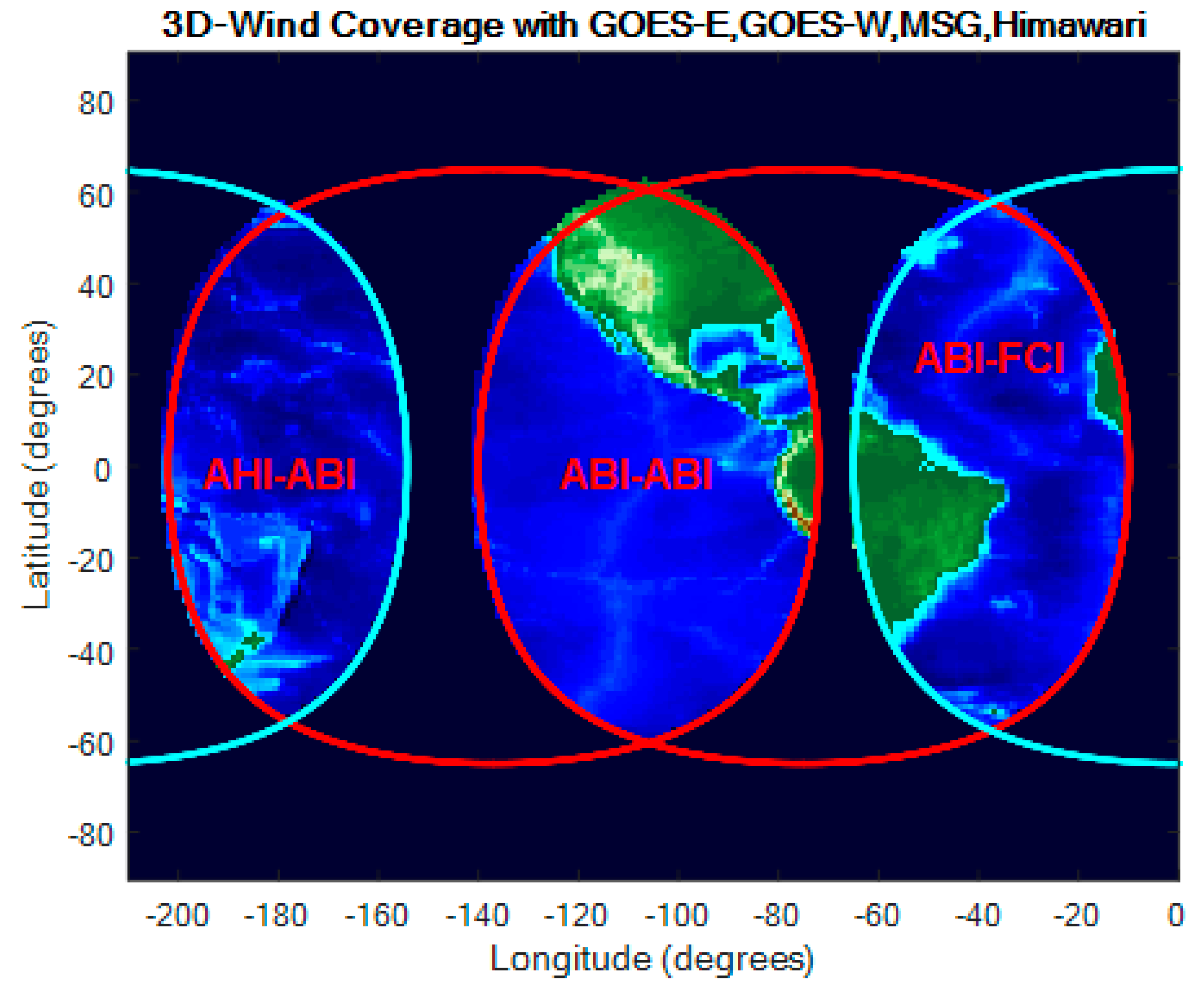


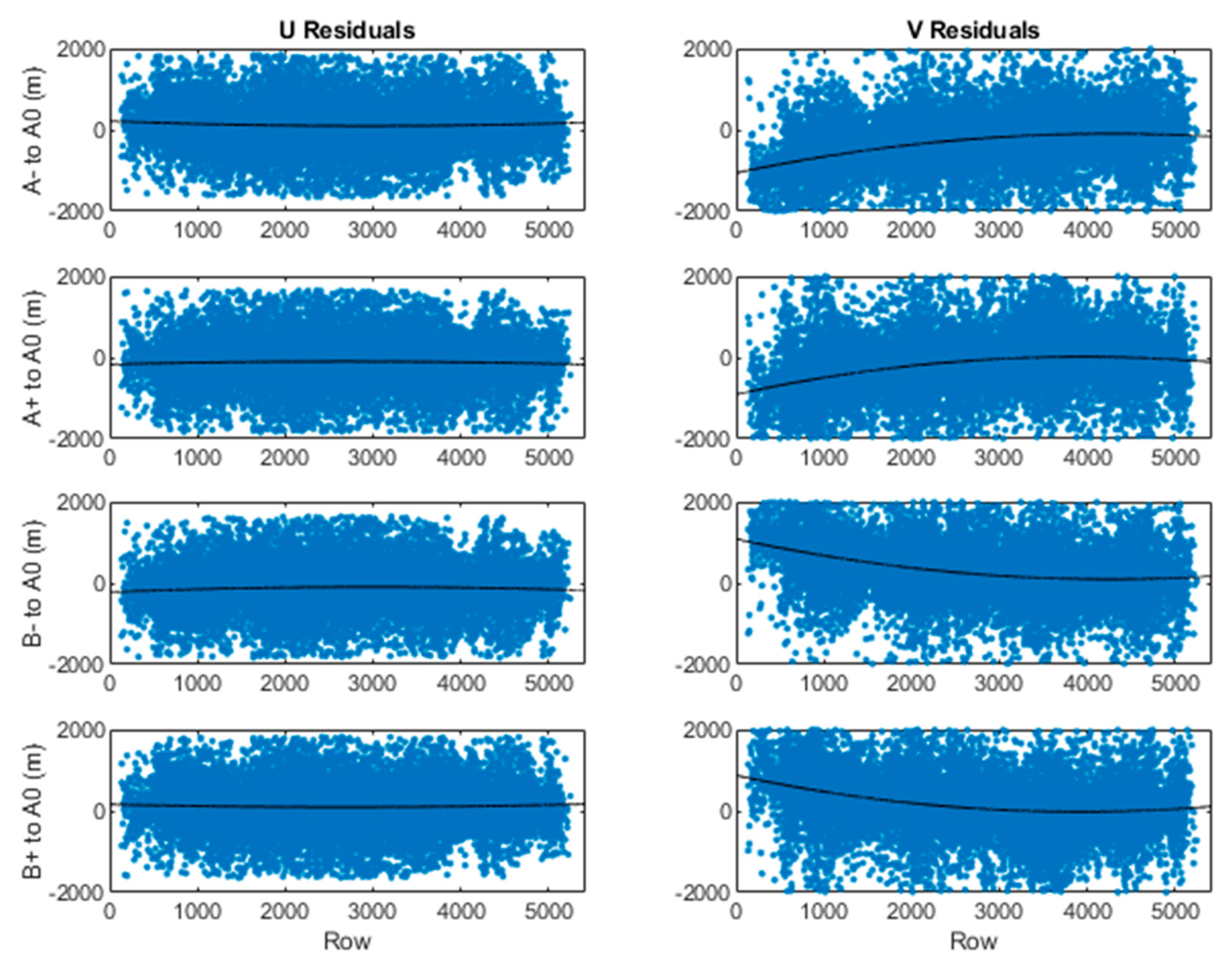
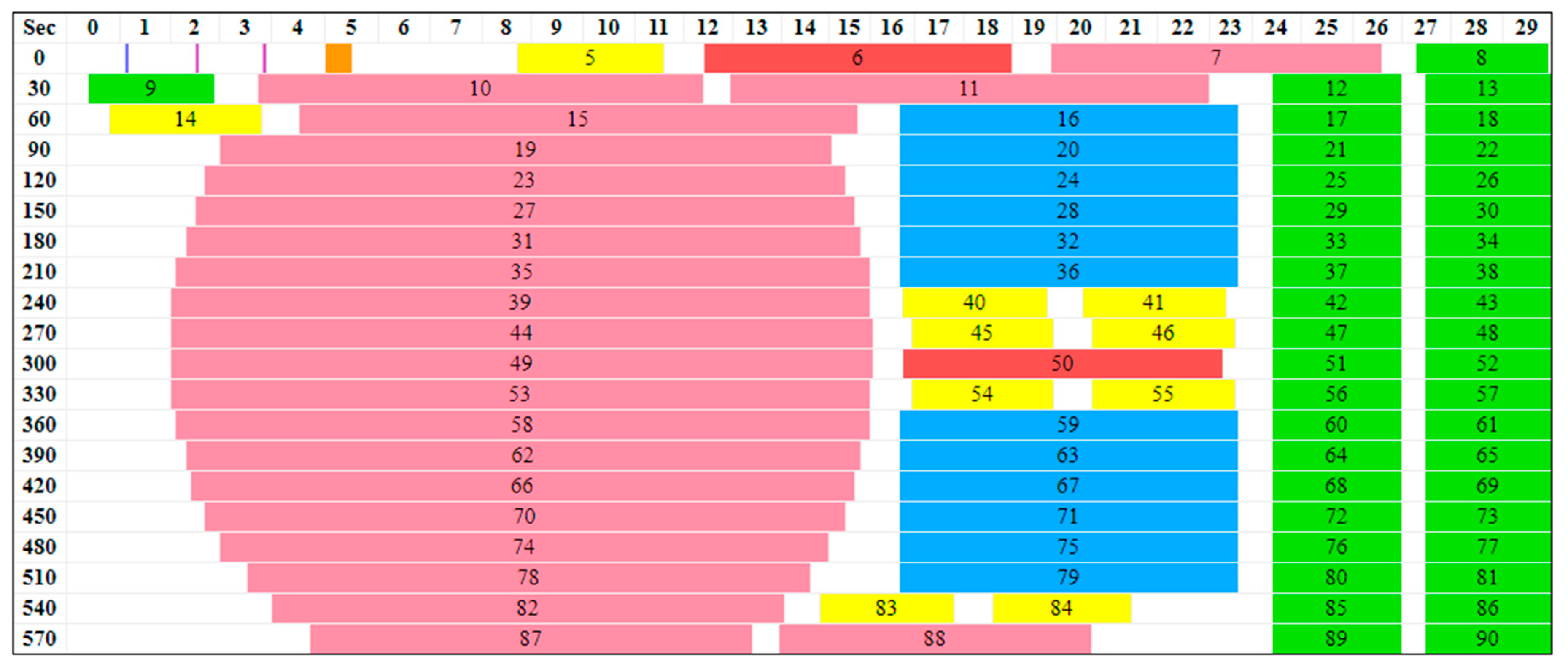



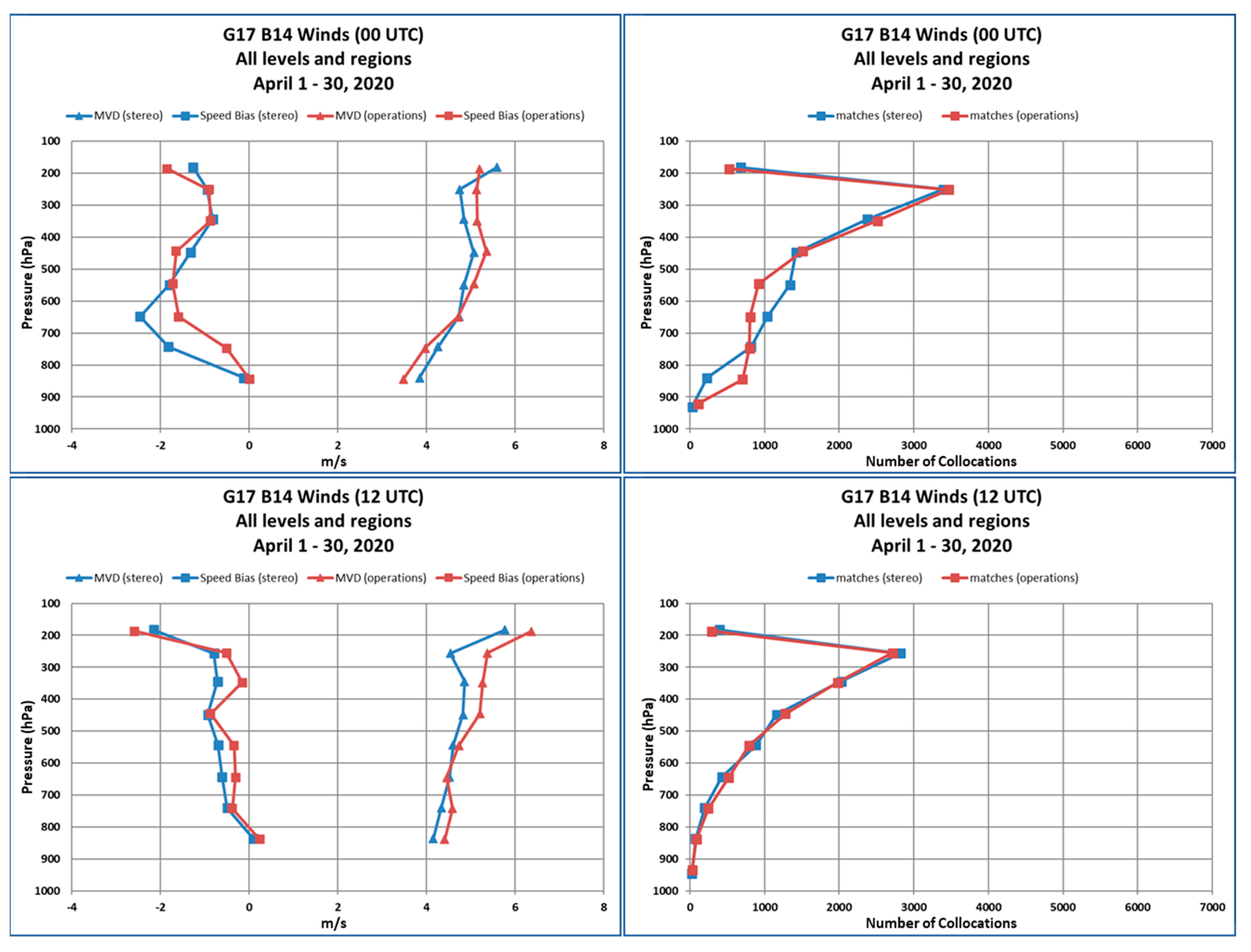

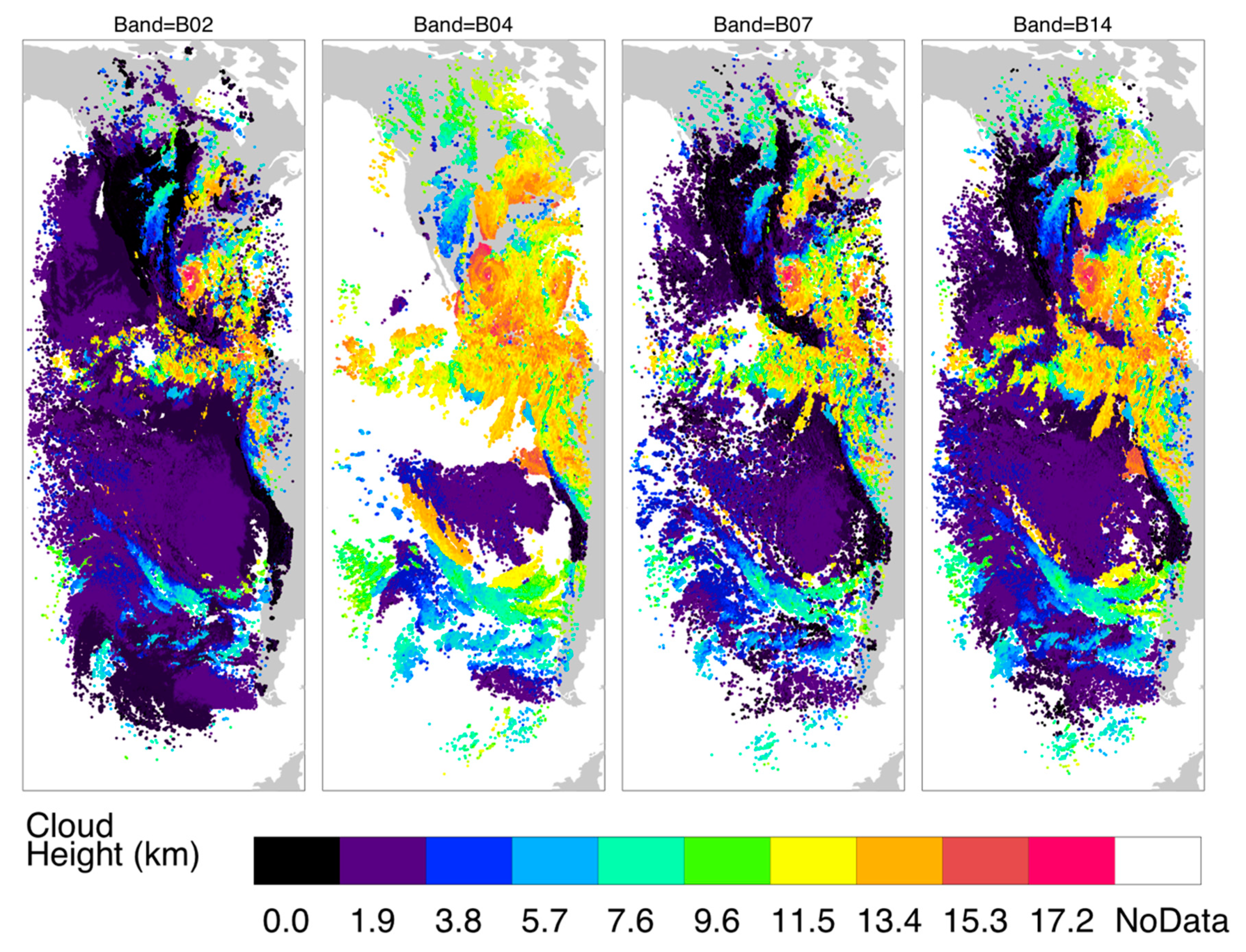
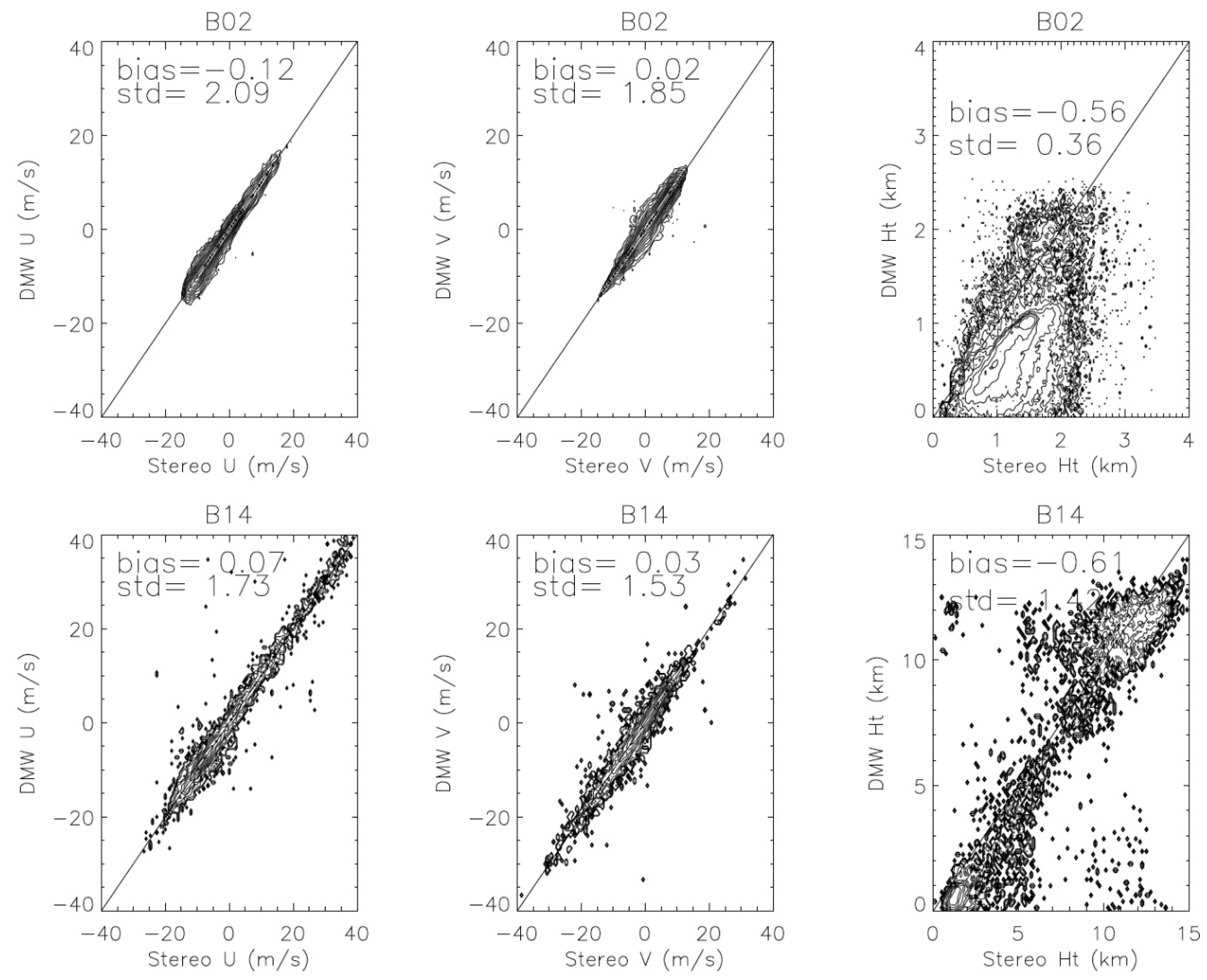


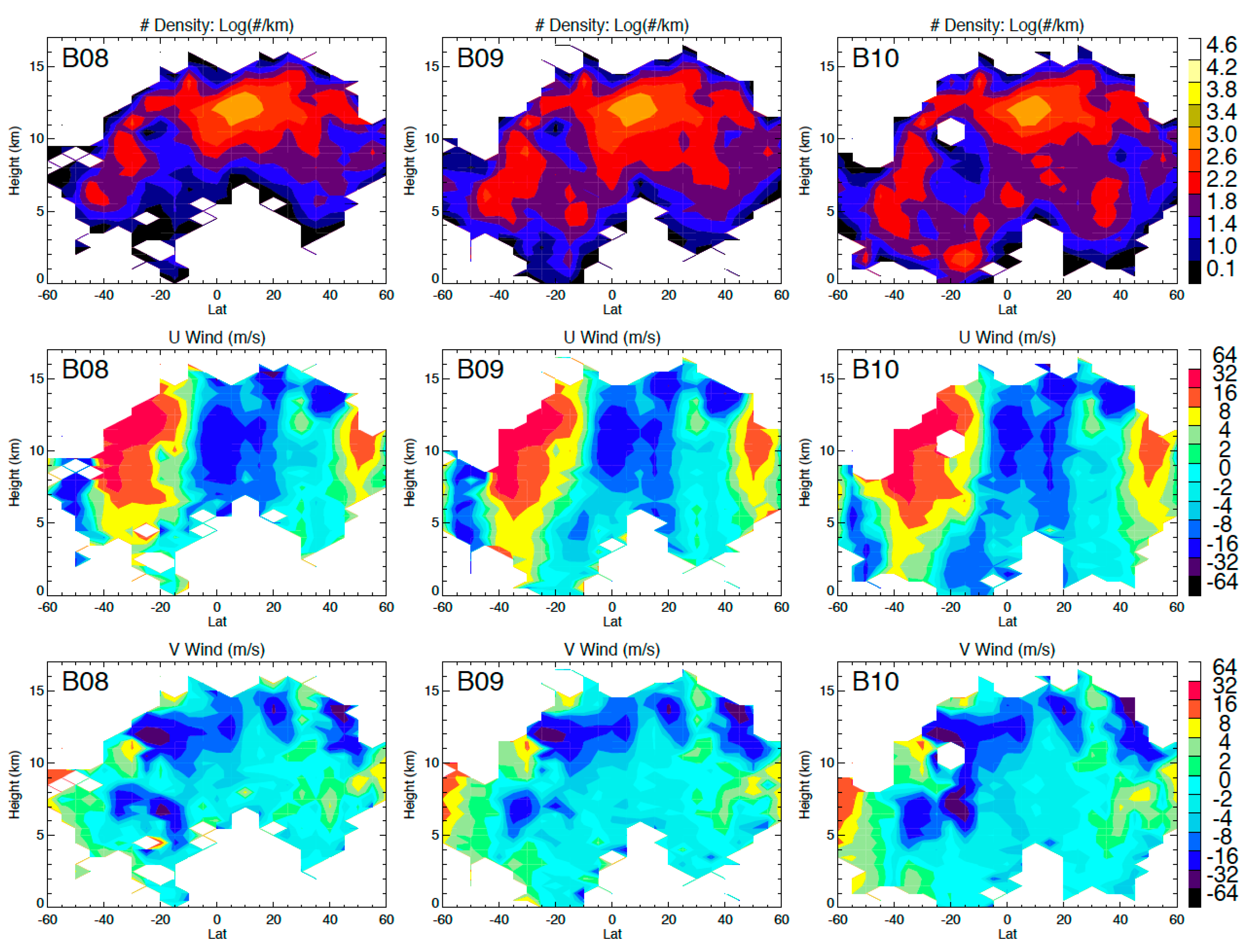
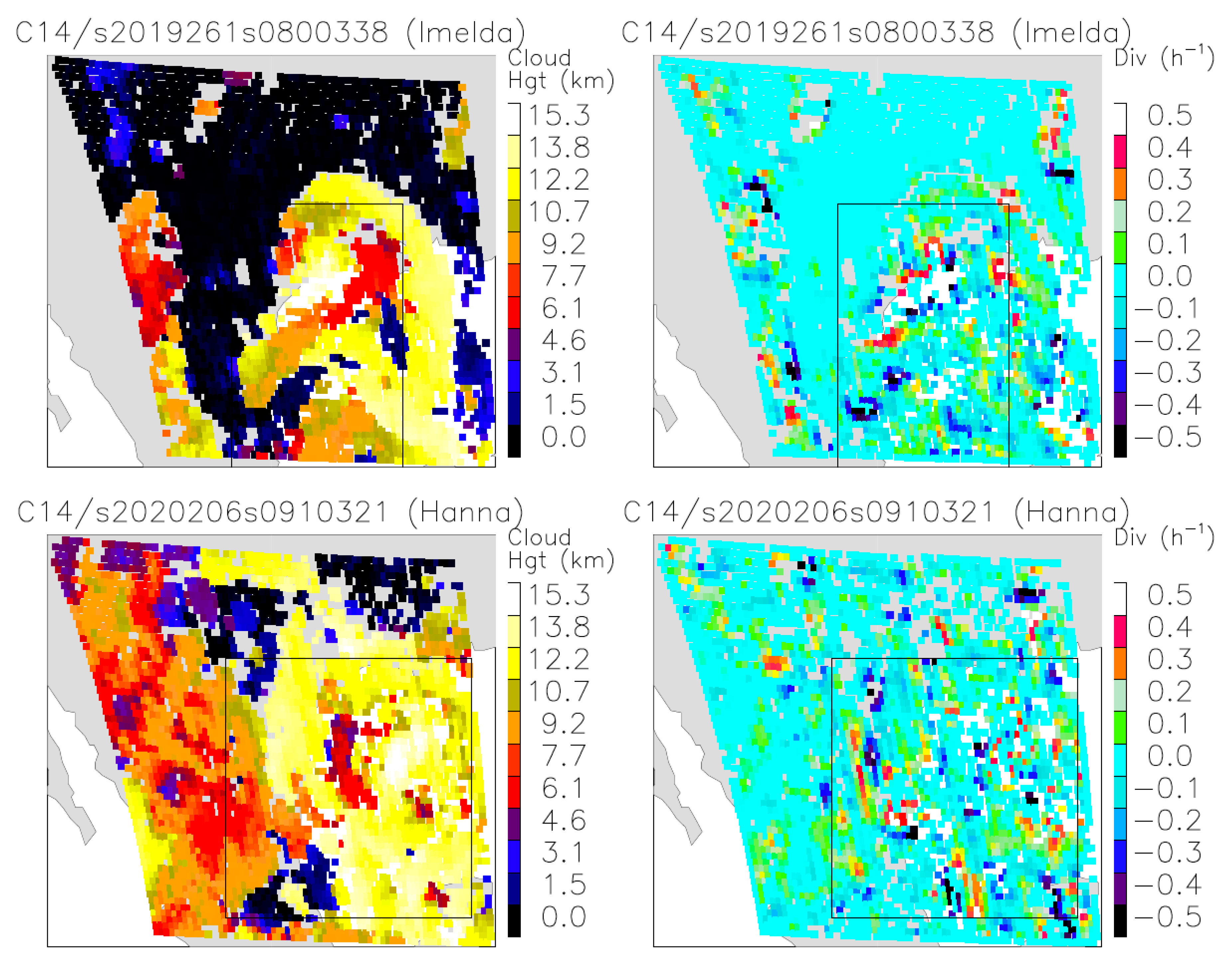

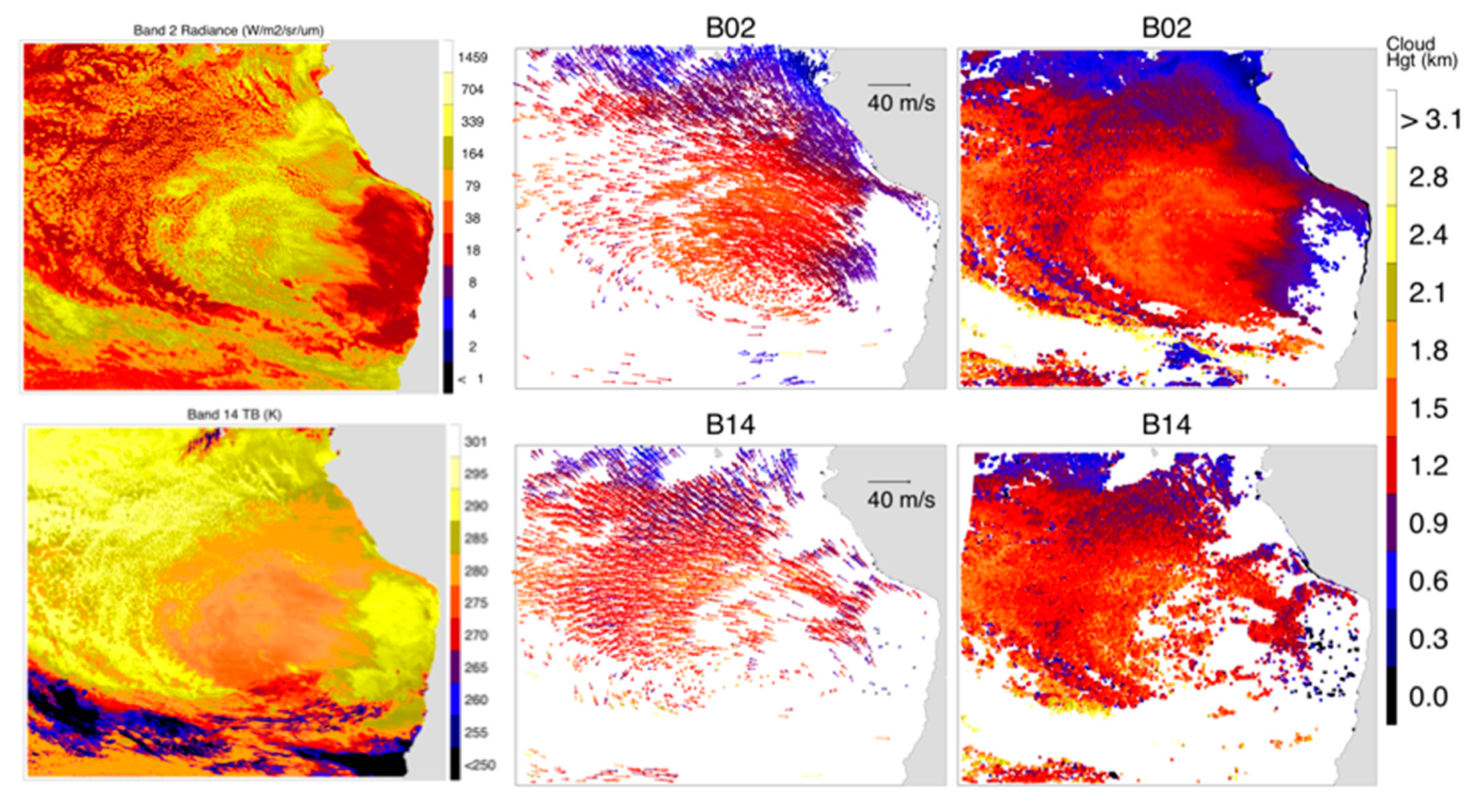

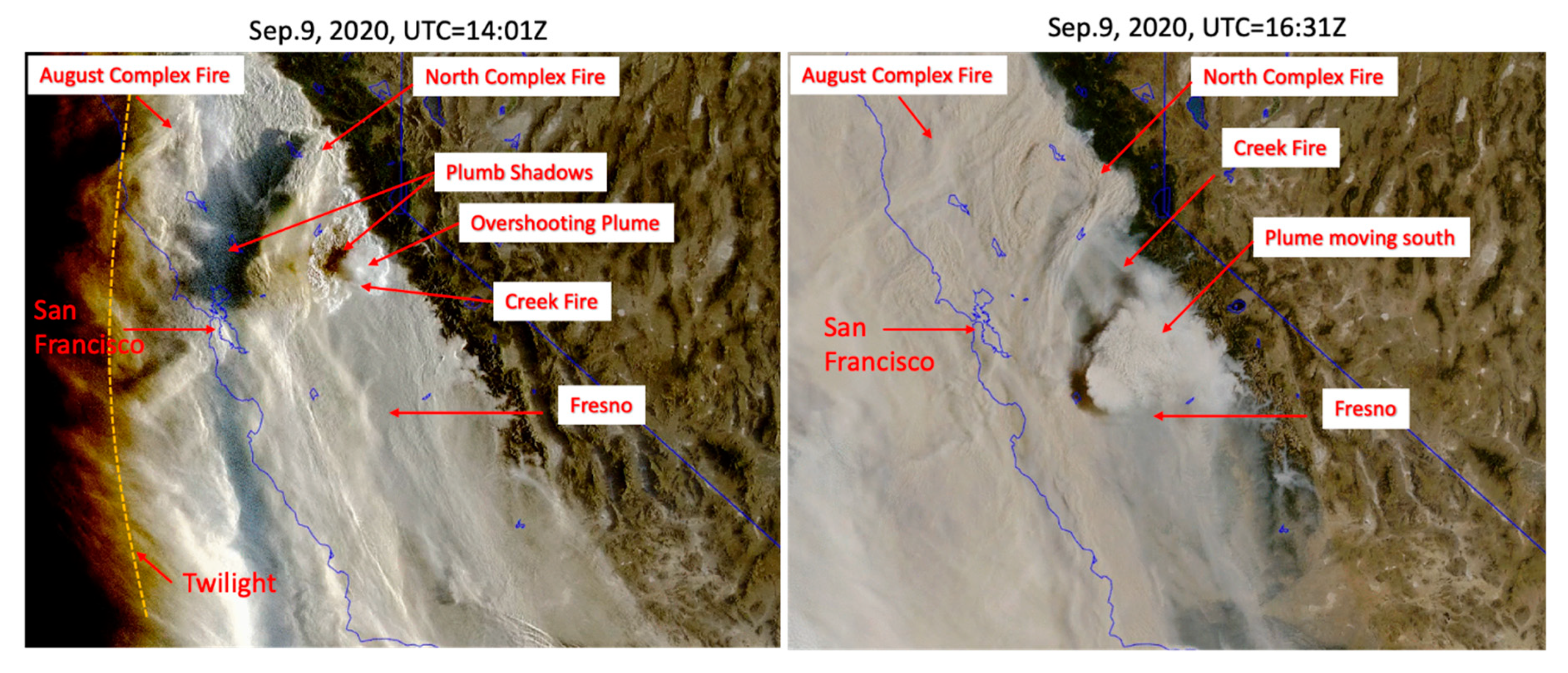
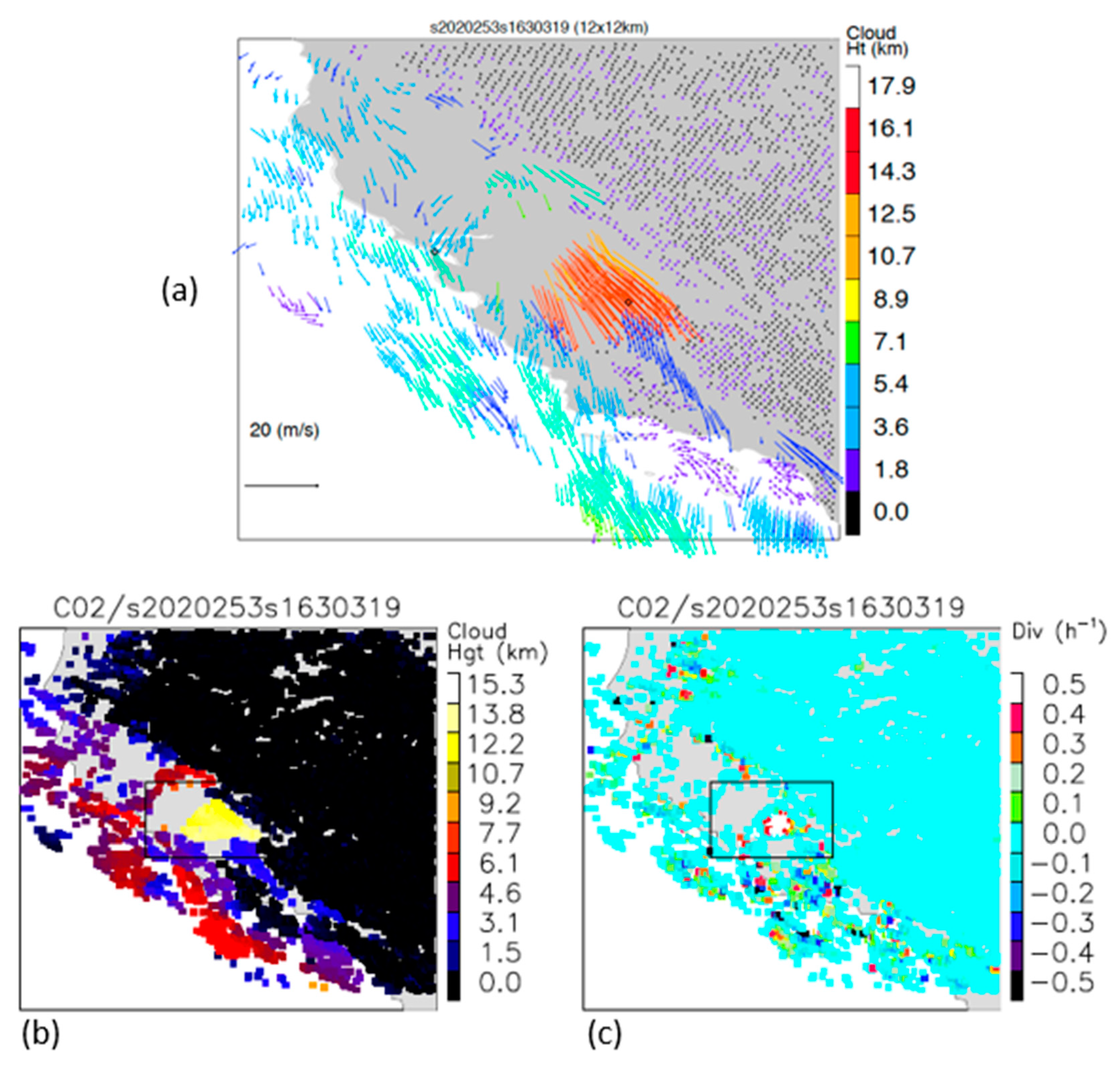
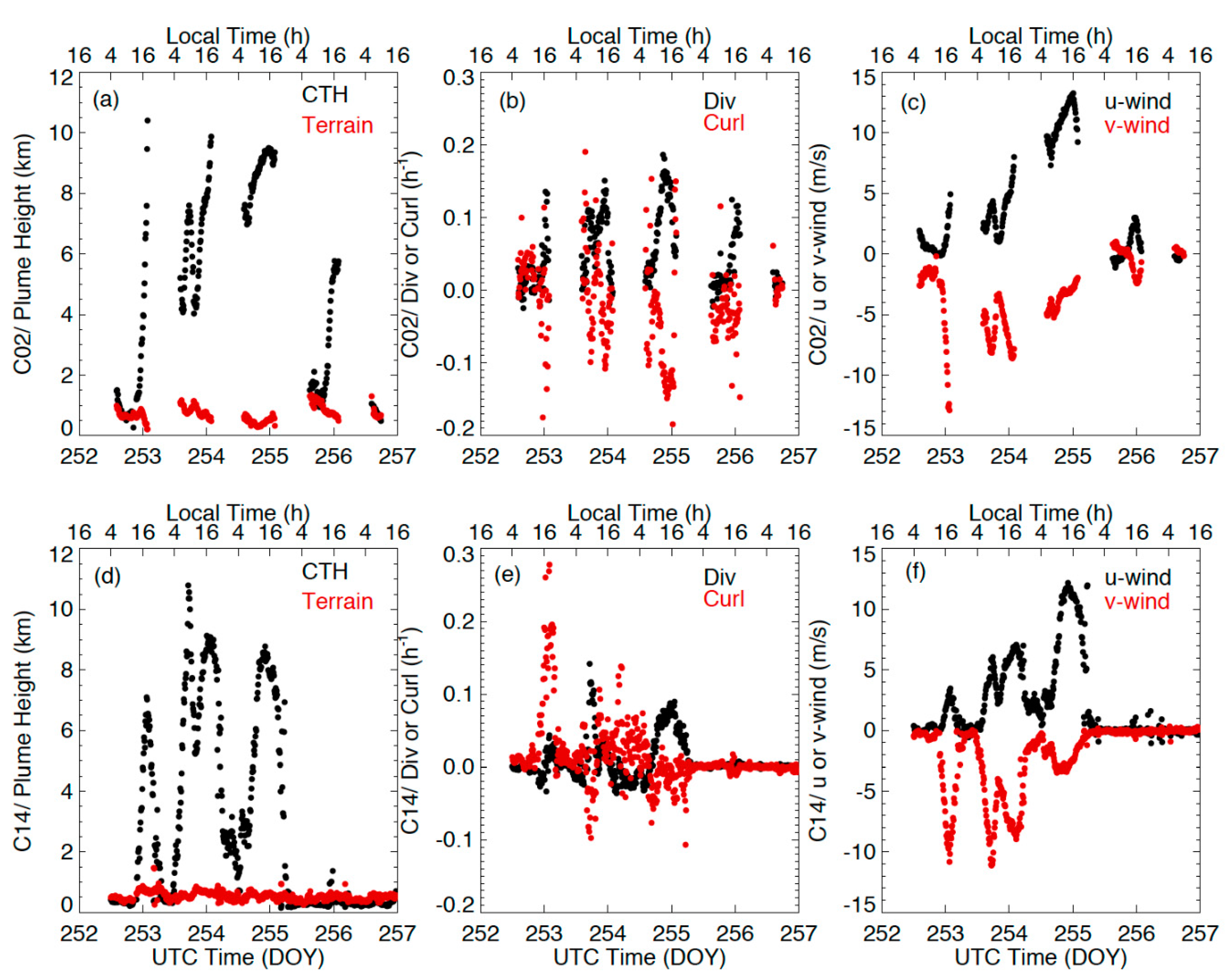

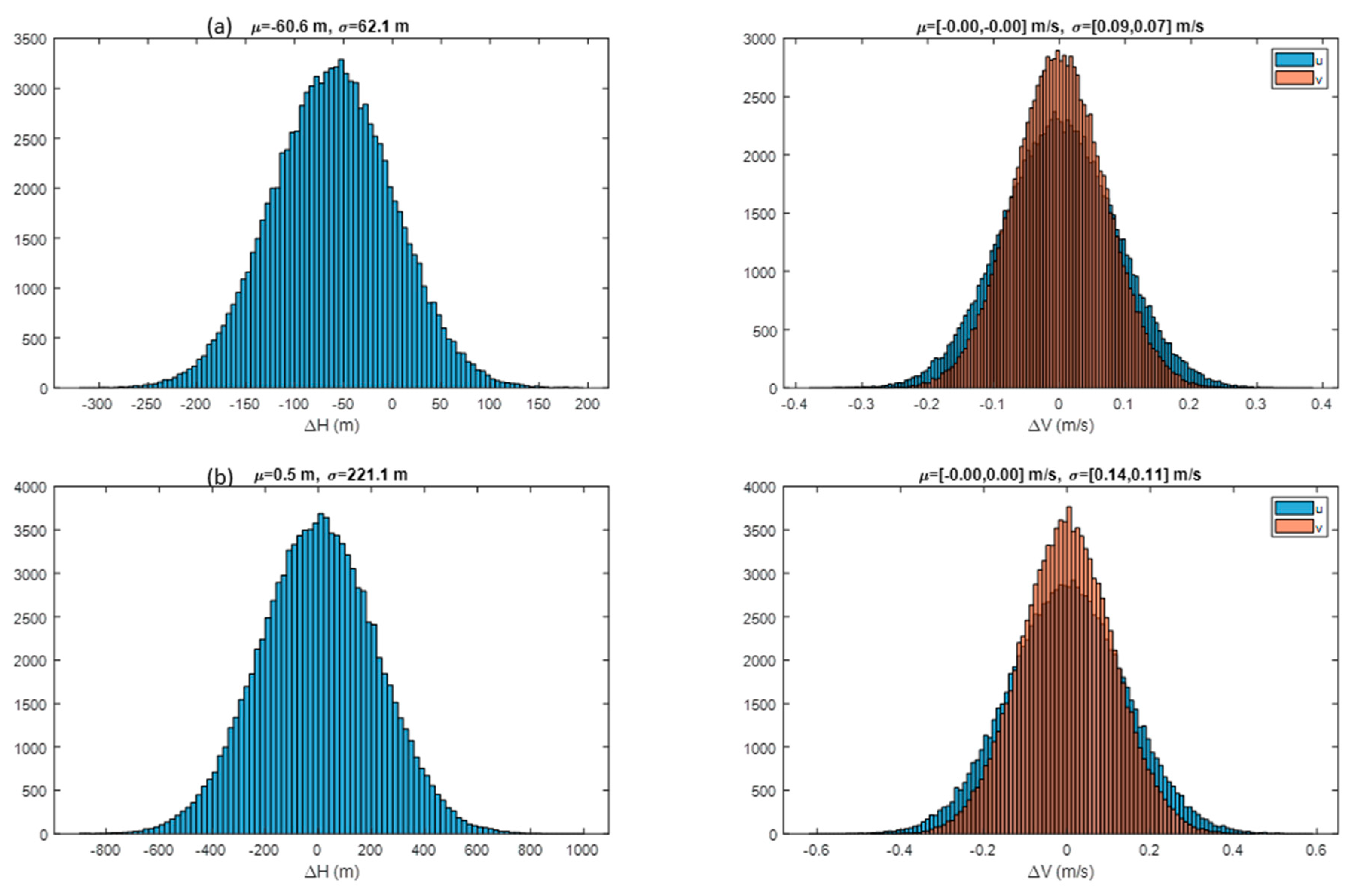

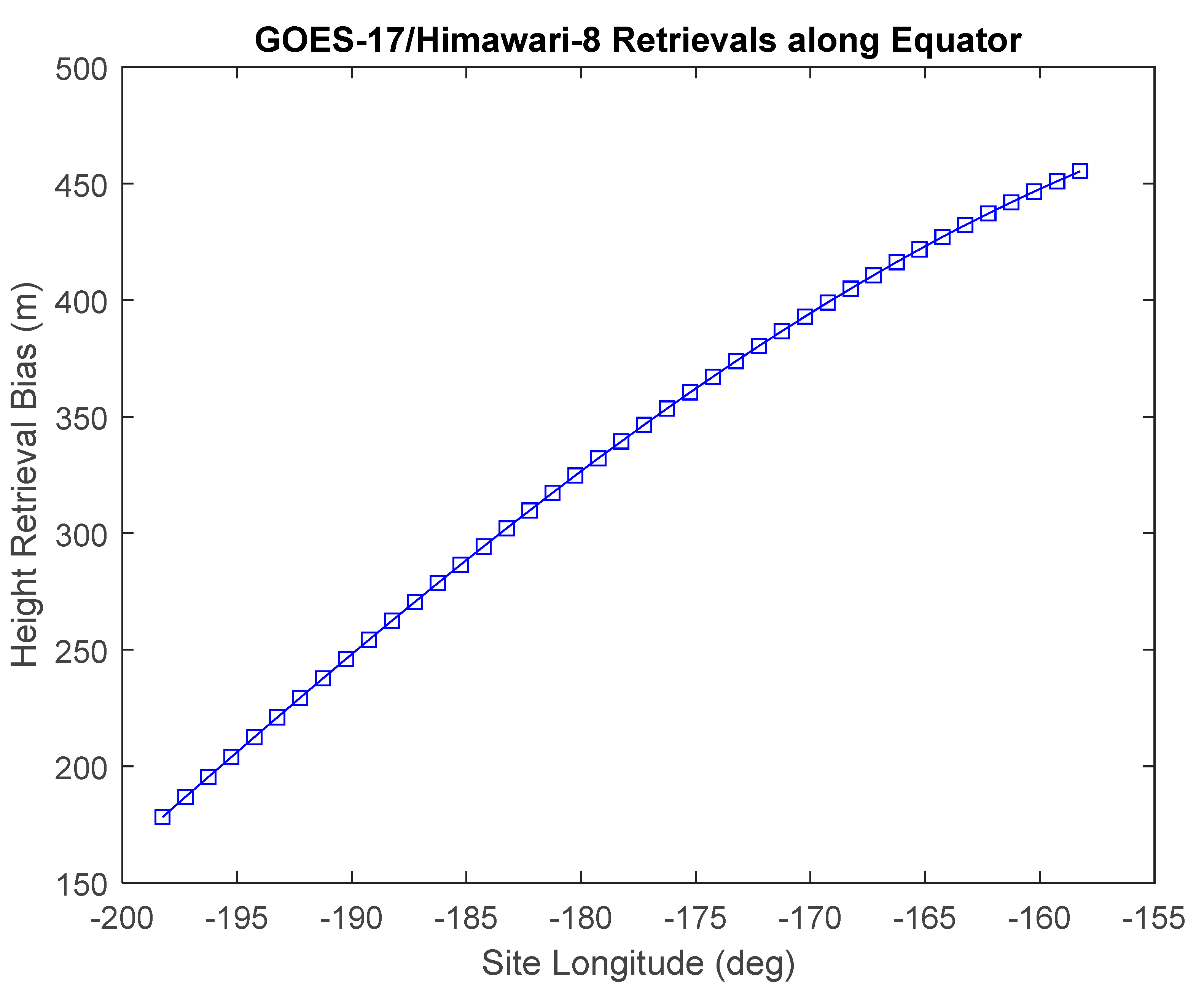
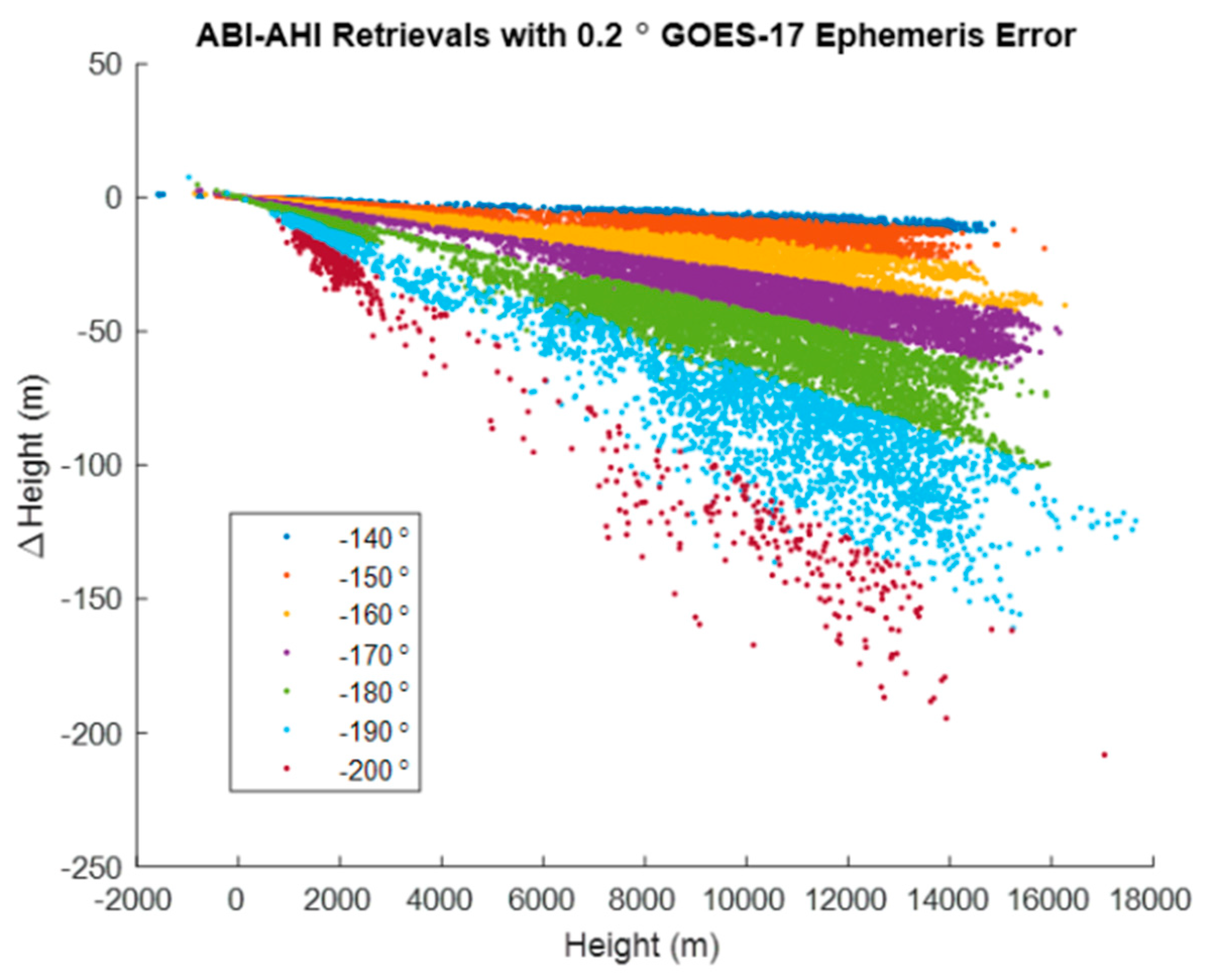
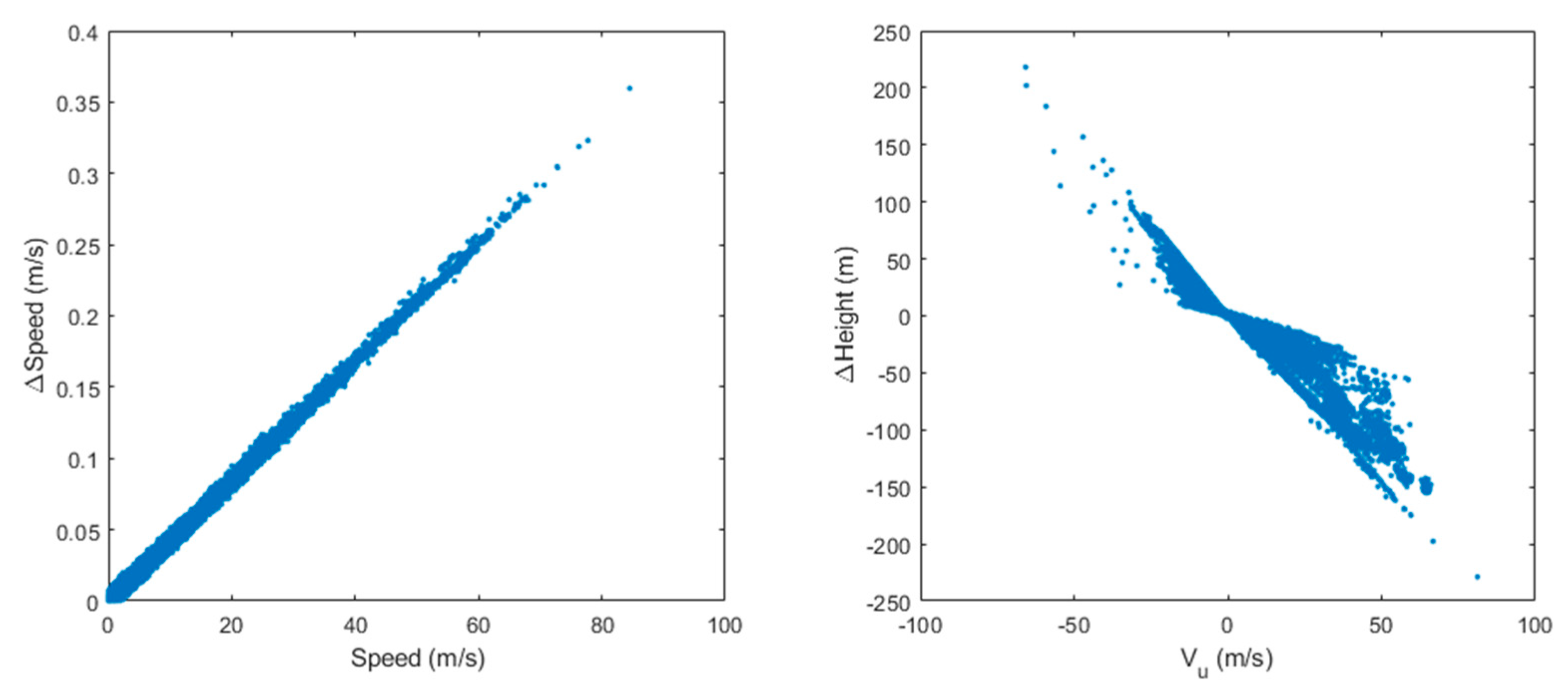
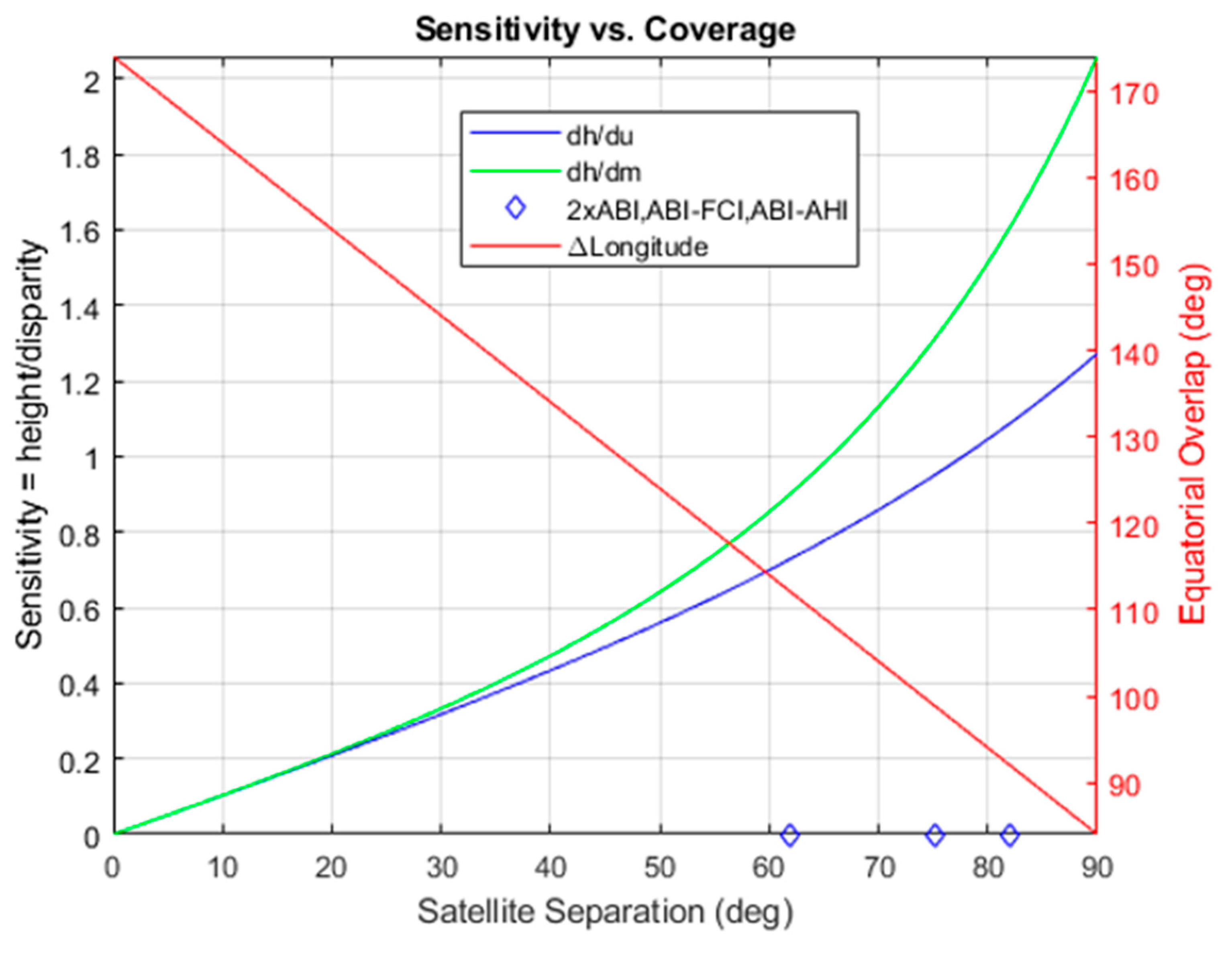

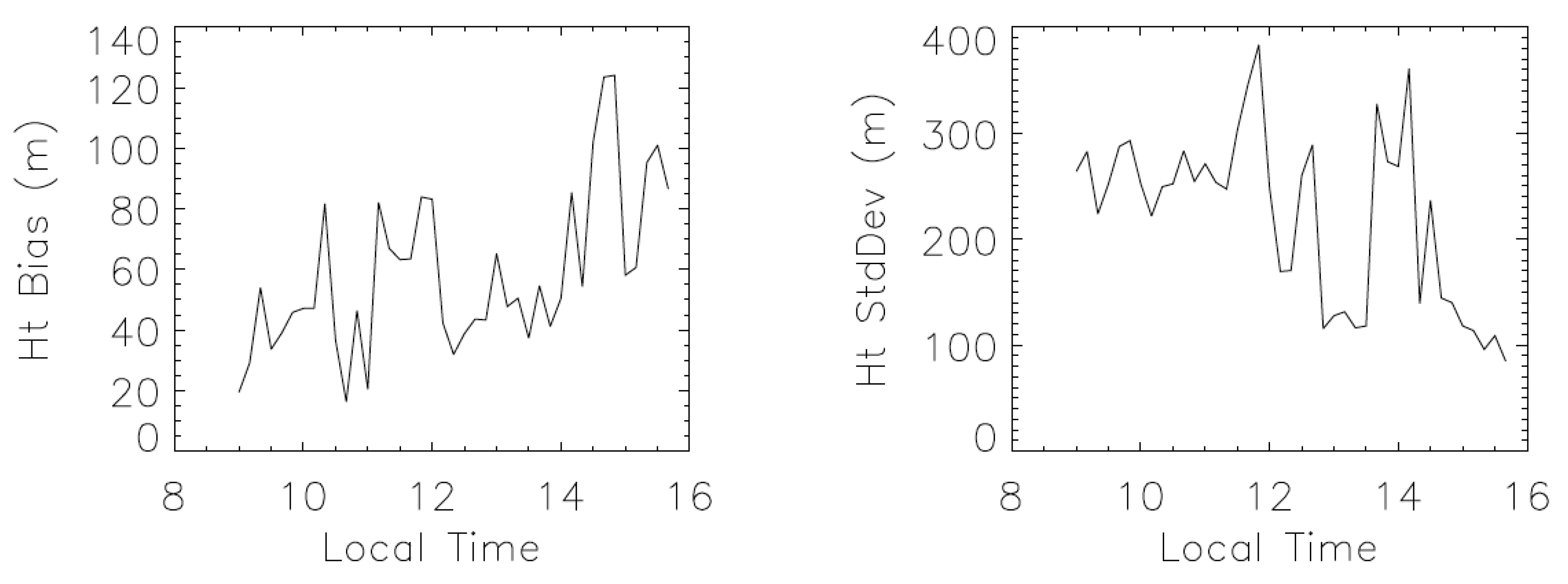
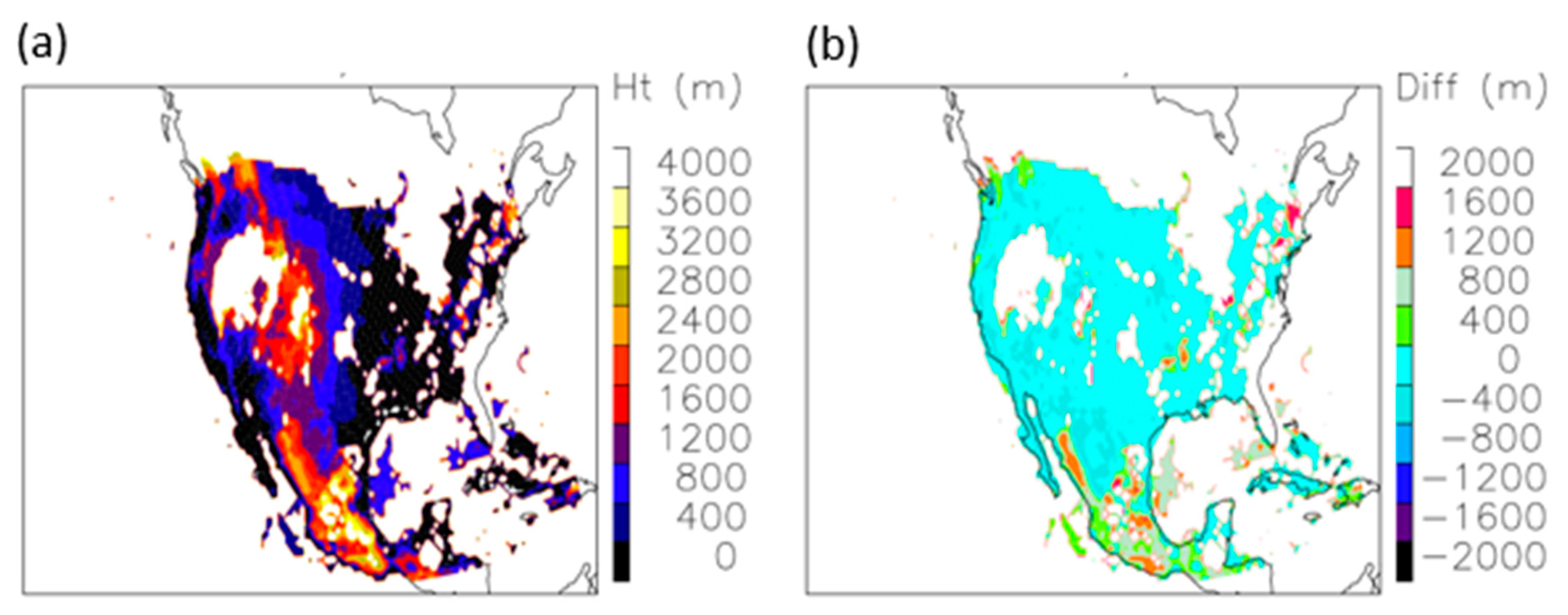
| GOES-R Series (ABI) | Himawari-8 (AHI) | ||||||||
|---|---|---|---|---|---|---|---|---|---|
| ABI Band | Resolution (km) * | Center Wavelength (μm) | Bandwidth (μm) | Bit Depth | AHI Band | Resolution (km) * | Center Wavelength (μm) | Bandwidth (μm) | Bit Depth |
| 1 | 1 | 0.47 | 0.04 | 10 | 1 | 1 | 0.4703 | 0.0407 | 11 |
| - | - | - | - | - | 2 | 1 | 0.5105 | 0.0308 | 11 |
| 2 | 0.5 | 0.64 | 0.10 | 12 | 3 | 0.5 | 0.6399 | 0.0817 | 11 |
| 3 | 1 | 0.8655 | 0.039 | 10 | 4 | 1 | 0.8563 | 0.0345 | 11 |
| 4 | 2 | 1.3785 | 0.015 | 11 | - | - | - | - | - |
| 5 | 1 | 1.61 | 0.06 | 10 | 5 | 2 | 1.6098 | 0.0409 | 11 |
| 6 | 2 | 2.250 | 0.050 | 10 | 6 | 2 | 2.257 | 0.0441 | 11 |
| 7 | 2 | 3.90 | 0.20 | 14 | 7 | 2 | 3.8848 | 0.2006 | 14 |
| 8 | 2 | 6.185 | 0.83 | 12 | 8 | 2 | 6.2383 | 0.8219 | 11 |
| 9 | 2 | 6.95 | 0.40 | 11 | 9 | 2 | 6.9395 | 0.4019 | 11 |
| 10 | 2 | 7.34 | 0.2 | 12 | 10 | 2 | 7.3471 | 0.1871 | 12 |
| 11 | 2 | 8.5 | 0.4 | 12 | 11 | 2 | 8.5905 | 0.3727 | 12 |
| 12 | 2 | 9.61 | 0.38 | 11 | 12 | 2 | 9.6347 | 0.3779 | 12 |
| 13 | 2 | 10.35 | 0.5 | 12 | 13 | 2 | 10.4029 | 0.4189 | 12 |
| 14 | 2 | 11.2 | 0.8 | 12 | 14 | 2 | 11.2432 | 0.6678 | 12 |
| 15 | 2 | 12.3 | 1.0 | 12 | 15 | 2 | 12.3828 | 0.9656 | 12 |
| 16 | 2 | 13.3 | 0.6 | 10 | 16 | 2 | 13.2844 | 0.5638 | 11 |
| Case | Start | Band | N | Height (m) | u-Wind (m/s) | v-Wind (m/s) | |||
|---|---|---|---|---|---|---|---|---|---|
| Stop | μ | σ | μ | σ | μ | σ | |||
| Western Orographic | 26 July 2019 17Z - 26 July 2019 23 Z | 2 | 1,184,516 | −8.3 | 96.3 | −0.03 | 0.06 | −0.03 | 0.07 |
| 7 | 82,832 | 24.6 | 184.8 | −0.02 | 0.11 | −0.05 | 0.12 | ||
| 14 | 34,733 | 76.4 | 176.7 | −0.01 | 0.11 | −0.03 | 0.12 | ||
| Hanna | 21 July 2020 5Z - 29 July 2020 17Z | 2 | 752,841 | 13.1 | 108.6 | −0.02 | 0.08 | −0.03 | 0.08 |
| 7 | 176,125 | 26.8 | 205.1 | −0.03 | 0.13 | −0.04 | 0.13 | ||
| 14 | 41,157 | 125.3 | 208.9 | −0.04 | 0.14 | −0.03 | 0.15 | ||
| Imelda | 17 Sep 2019 5Z - 23 Sep 2019 17Z | 2 | 588,193 | −3.4 | 84.0 | −0.02 | 0.08 | −0.03 | 0.08 |
| 7 | 520,547 | −7.2 | 171.4 | −0.01 | 0.13 | −0.03 | 0.12 | ||
| 14 | 245,513 | 50.7 | 195.5 | −0.01 | 0.14 | −0.03 | 0.14 | ||
| Creek Fire | 8 Sep 2020 12Z - 13 Sep 0Z | 2 | 3,615,312 | 6.2 | 172.7 | −0.01 | 0.09 | −0.04 | 0.10 |
| 7 | 491,027 | 4.2 | 230.8 | −0.01 | 0.12 | −0.05 | 0.12 | ||
| 14 | 455,228 | 29.1 | 234.1 | −0.01 | 0.12 | −0.06 | 0.12 | ||
| Comparison Metrics (All Levels, Latitudes) | GOES-17/GOES-16 Stereo Winds | GOES-17 Operational Winds |
|---|---|---|
| Mean Vector Difference (m/s) | 4.79 | 4.97 |
| Speed Bias (m/s) | −1.09 | −0.79 |
| Average Speed (m/s) | 22.33 | 22.34 |
| Absolute Direction Difference (deg) | 10.46 | 10.76 |
| Common Sample Size | 17,999 | |
| Template Size | Heights > 2 km | Heights > 5 km | ||||
|---|---|---|---|---|---|---|
| Band 8 | Band 14 | Ratio | Band 8 | Band 14 | Ratio | |
| 12 × 12 | 17.7% | 13.8% | 1.3:1 | 17.5% | 11.3% | 1.5:1 |
| 24 × 24 | 37.4% | 26.1% | 1.4:1 | 36.8% | 21.1% | 1.7:1 |
| 48 × 48 | 53.6% | 33.6% | 1.6:1 | 52.6% | 27.5% | 1.9:1 |
| 96 × 96 | 59.6% | 39.0% | 1.5:1 | 58.3% | 32.2% | 1.8:1 |
| East-West (u) +1 km | North-South (v) +1 km | |||||||||
|---|---|---|---|---|---|---|---|---|---|---|
| State | A− | A0 | A+ | B− | B+ | A− | A0 | A+ | B− | B+ |
| (m) | 250 | −1000 | 250 | 250 | 250 | 0 | 0 | 0 | 0 | 0 |
| (m) | 0 | 0 | 0 | 0 | 0 | 248 | −993 | 248 | 248 | 248 |
| (m) | −343 | 0 | −343 | 343 | 343 | 0 | 0 | 0 | 0 | 0 |
| (m/s) | −0.83 | 0 | 0.83 | −0.83 | 0.83 | 0 | 0 | 0 | 0 | 0 |
| (m/s) | 0 | 0 | 0 | 0 | 0 | −0.83 | 0 | 0.83 | −0.83 | 0.83 |
| (m) | 500 | 0 | 500 | 500 | 500 | 702 | 0 | 702 | 702 | 702 |
Publisher’s Note: MDPI stays neutral with regard to jurisdictional claims in published maps and institutional affiliations. |
© 2020 by the authors. Licensee MDPI, Basel, Switzerland. This article is an open access article distributed under the terms and conditions of the Creative Commons Attribution (CC BY) license (http://creativecommons.org/licenses/by/4.0/).
Share and Cite
Carr, J.L.; Wu, D.L.; Daniels, J.; Friberg, M.D.; Bresky, W.; Madani, H. GEO–GEO Stereo-Tracking of Atmospheric Motion Vectors (AMVs) from the Geostationary Ring. Remote Sens. 2020, 12, 3779. https://doi.org/10.3390/rs12223779
Carr JL, Wu DL, Daniels J, Friberg MD, Bresky W, Madani H. GEO–GEO Stereo-Tracking of Atmospheric Motion Vectors (AMVs) from the Geostationary Ring. Remote Sensing. 2020; 12(22):3779. https://doi.org/10.3390/rs12223779
Chicago/Turabian StyleCarr, James L., Dong L. Wu, Jaime Daniels, Mariel D. Friberg, Wayne Bresky, and Houria Madani. 2020. "GEO–GEO Stereo-Tracking of Atmospheric Motion Vectors (AMVs) from the Geostationary Ring" Remote Sensing 12, no. 22: 3779. https://doi.org/10.3390/rs12223779
APA StyleCarr, J. L., Wu, D. L., Daniels, J., Friberg, M. D., Bresky, W., & Madani, H. (2020). GEO–GEO Stereo-Tracking of Atmospheric Motion Vectors (AMVs) from the Geostationary Ring. Remote Sensing, 12(22), 3779. https://doi.org/10.3390/rs12223779






